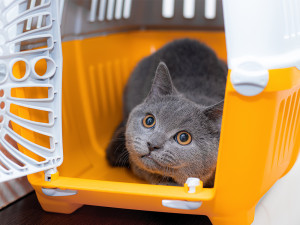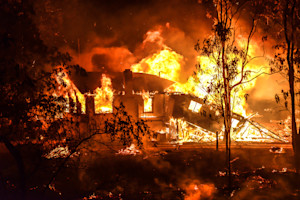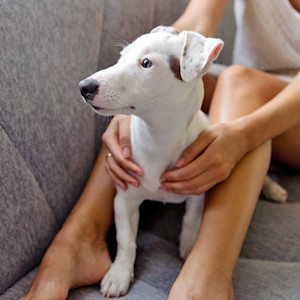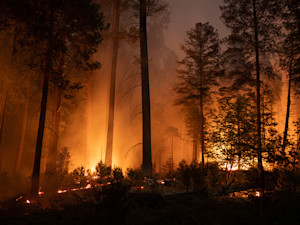How to Evacuate a Natural Disaster With Your Pet
What you need to do, have, and know in the moment (hopefully, it never comes).
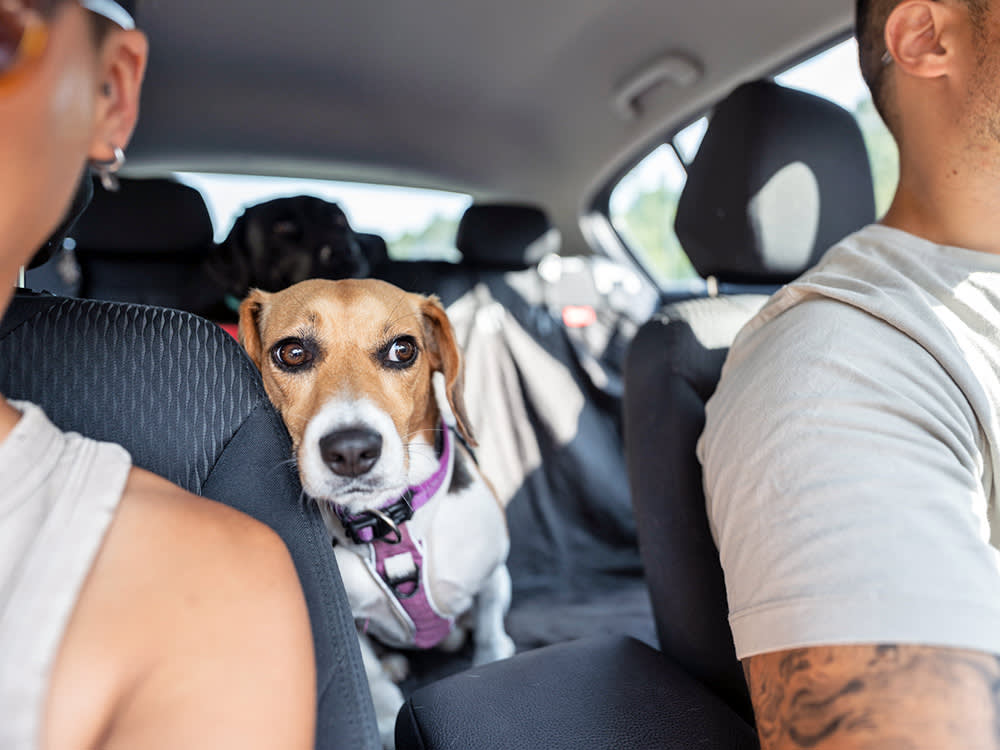
Share Article
This month, almost 200,000 people were forced to evacuate their homes because of out-of-control wildfires in Los Angeles earlier this month. Alongside many of these people were pets of all kinds: dogs, cats, birds, and even larger animals, including horses and donkeys. The danger of these fires continue, with another breaking out opens in a new tab about 50 miles north of LA on Wednesday, causing 31,000 people to evacuateopens in a new tab.
Videos circulating online show how perilous some of these evacuations were, likely due to the unforeseen escalation of the fires. However, they also serve as a stark reminder of how crucial proper evacuation procedure is, especially when evacuating with pets. To help, we put together this expert-backed guide on how to evacuate safely with your pets in the event of a natural disaster.

littleKin™ is Kinship’s home just for puppy and kitten parents. Bop over to check out expert advice, new pet tools, and special deals—all curated for your newest family member.
opens in a new tabSecure and protect your pet
Here’s the hard truth: Sometimes, perfectly prepared and relaxed pets will still bolt at a moment’s notice during an emergency. With that said, no amount of training can replace a secure, escape-proof harnessopens in a new tab, leash, and carrier during an evacuation. Depending on the conditions of your evacuation, Bassett also recommends investing in the following protective gear.
First-aid kit
If you can, pick up a pet specific first-aid kitopens in a new tab, complete with (certain) pet-safe, over-the-counter medications. However, in a pinch, you can also create your own kit from what you have at home, excluding medications opens in a new tabdesigned for humans.
“Include essentials like gauze, bandages, antiseptic wipes, tweezers, and styptic powder,” Bassett recommends.
Pet respiratory protection
If you live in an area at risk for wildfiresopens in a new tab, a pet-designed respirator mask is a great protectant for your pet against unsafe air and debris. If you’re unable to acquire a mask designed for your pet, don’t try to retrofit one that’s made for humans. Instead, Bassett recommends using something else to keep your pet safe: “In smoky conditions, minimize your pet’s exposure to harmful air by staying indoors or using a damp cloth to gently shield their nose/mouth.��”
Boots or paw protection
She adds: “Protect pets’ paws from hot surfaces, debris, or toxic substances with booties opens in a new tab or a thick layer of paw wax.” For more information on protecting your dog’s paws, check out our guide hereopens in a new tab.
Reflective gear
“Use reflective vests, LED collars, or glow sticks for visibility if evacuating in low light or chaotic conditions,” Bassett says.
Finally, remember that no matter how safe and secure you are able to make your pet, you should never leave them in the car unattended. Extreme temperatures and bad weather are already dangerousopens in a new tab in non-evacuation scenarios. But the added stress of an evacuation can cause your pet to panic and overheat even quicker than usual. In addition, an unattended dog or cat in a stressful scenario is more likely to panic and escape or hurt themselves trying.
Acclimating and monitoring your pet post-evacuation
In the hours and days after an evacuation, it’s normal for pets to experience heightened separation anxietyopens in a new tab, sleep issues, or decreased appetiteopens in a new tab as a result of the stress. Especially if you and your pets are sheltering in an unfamiliar location, pets might also experience potty training regression or excessive stress behaviors, like barkingopens in a new tab or pacing.
Be patient with your pet as they decompress from a highly stressful event and adjust to their new normal. To support this process, pet parents should try to get their pets back into a routine and add in positive, high-value enrichment activitiesopens in a new tab, like lick mats or puzzle feeders.
Remember, some behaviors post-evacuation are more normal than others. If your pet is experiencing prolonged stress symptoms, such as vomiting, diarrhea, or excessive coughingopens in a new tab or hacking, contact a vet immediately.
Remain calm
Any pet parent knows that dogs and cats pick up on emotions quickly, particularly stressopens in a new tab. That means the best way to keep your pet calm and safe during an evacuation is to remain chill yourself. If possible, remember to keep your voice low and avoid frenetic movement.
Of course, there are many variables during an evacuation that are simply out of your control. Especially during natural disasters, elements like wind, thunder, or smoke can trigger or panic your pet, no matter how much inner calm you’re projecting.
Thinking ahead: train for evacuation
As much as it’s important to know what to do when circumstances change at a moment’s notice, there are things you can do ahead of time to make “go time” a little less scary. One of the best ways to prepare your pet for evacuation is to equip them with the proper training.
Of course, training your pet to evacuate is a little more involved than getting them to do one trick, like “roll over.” Evacuation training involves teaching your pet a combination of behaviors and skills that will keep them safe and calm during an emergency.
To learn more, we asked Alexandra Bassettopens in a new tab, lead dog trainer and behavior consultant at Dog Savvy in LA, to break down exactly what types of training can help during an evacuation.
Get them comfortable with carriers and leashes
“Get pets comfortableopens in a new tab with their carriers and leashes well in advance,” Bassett tells Kinship. “Practice having them willingly enter their carrier and reward them to create a positive association.”
Crate-training
“ Crate-trained pets are easier to transport safely during an evacuation. Start crate-training opens in a new tabas part of their daily routine,” Basset says.
Recall training
“Teach pets to reliably comeopens in a new tab when called,” Bassett adds. “This is critical for locating pets quickly during emergencies.”
Cue-conditioning
Bassett also says it’s important to come up with a phrase that your dog associates with a serious situation like this. “Condition your pet to respond calmly to a specific cue (i.e., ‘let’s go’ or a whistle) that signals an emergency evacuation is starting.”
Once your pet has gotten a handle on these behaviors, Bassett recommends conducting a mock evacuation that will simulate the real steps you and your pet will need to take in an emergency. “Simulate packing your ‘go bag,’ loading your pet into the car, and taking a short trip to help familiarize them with the process.”
Your go-bag checklist
Comfort items
Bassett says: “Bring familiar items such as their favorite toys, blankets, or a piece of your clothing that smells like you.opens in a new tab”
Pheromone products
Basset says: “ Use calming pheromonesopens in a new tab, like Adaptil for dogsopens in a new tab or Feliway for catsopens in a new tab, to reduce stress.” CBD is also a good optionopens in a new tab for your pet, especially if it’s something they usually consume to help with anxiety.
Medication
Basset says: “If your pet is highly anxious, consult your veterinarian about anxiety medication that can be used during stressful situations.”
In addition, your dog’s “go-bag” should include the following items:
Between three to seven days’ worth of food (rotate every two months)
At least a week’s worth of bottled water per pet (replace every two months)
Sanitation supplies, like grooming wipes
Can opener for wet food
Leashes and harnessesopens in a new tab, cat carriersopens in a new tab, dog cratesopens in a new tab
FAQs
What should I do if I can’t bring my pet to my evacuation location?
In the event of a large-scale natural disaster, local and national rescues will often organize programs for displaced pets. These orgs will work with you to find a temporary foster home that will allow you to reunite with your pet once you find pet-friendly accommodations.
What should I do if my pet runs away during a natural disaster or evacuation?
“ Pet parents should reach out to local shelters and rescues to alert them of a lost pet, and post on community websites like Facebook groups, NextDoor, etc., with recent photos and instructions on how to contact you,” advises Mallory Kerley, marketing director at Muddy Paws Rescueopens in a new tab. “A simple graphic should be made with a large photo, the world’s lost [message that says] ‘lost dog/cat’ on top, and your name and phone number so others can share with their networks.”
Practically speaking, successful reunification between pets and their parents often comes down to an important preventative measure: microchipping. “We can’t stress enough how important a microchipopens in a new tab is, with up-to-date contact information,” Kerley says. “This is the most important thing you can do to ensure reunification if your pet goes missing during a crisis or evacuation.”

Rebecca Caplan
Rebecca Caplan is a writer based in Brooklyn whose work has been featured in The New Yorker, Reductress, and Vulture. She lives in Brooklyn with her perfect, toothless dog Moose.
Related articles
![Annie Harvilicz, 47, opened her home and an empty pet hospital to more than 40 dogs and cats.]() opens in a new tab
opens in a new tabVet Opens Empty Hospital to Care for Over 40 Pets Displaced by the Los Angeles Wildfires
“For every person who needed help, there were 50 people offering to help.”
![Destructive California Wildfires Burn Across L.A., Including Hollywood.]() opens in a new tab
opens in a new tabHow to Help Pets Affected by the Devastating LA Fires
See which local shelters are taking pets (and who needs your donations right now).
![Despite being both mentally and physically exhausted, our team in Los Angeles is still showing up to help both the community and shelters in need.]() opens in a new tab
opens in a new tabHow to Adopt or Foster Pets That Have Been Affected by the LA Fires
Show up for the shelters and rescues in need right now.
![Woman sitting on couch with a scared, white dog.]() opens in a new tab
opens in a new tabHow to Keep Your Pet Safe During a Hurricane and Other Natural Disasters
A VCA Animal Hospital expert explains everything you need to know about preparing for a natural disaster.
![Forrest fire.]() opens in a new tab
opens in a new tabFires Are Devastating LA. Here’s How to Keep Your Pet Safe
What you need to know if wildfires affect your community.
